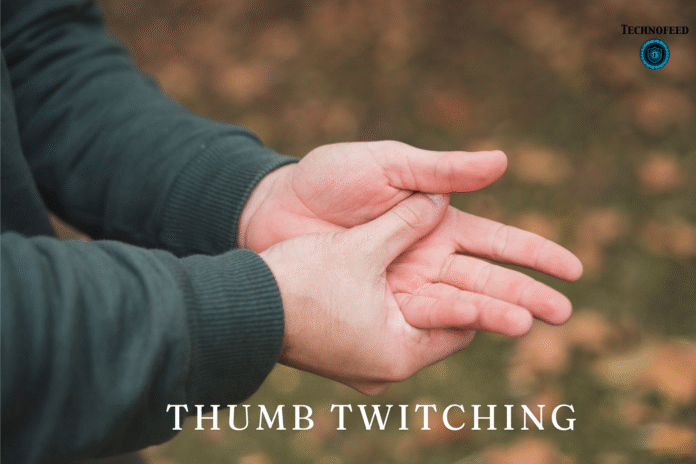Thumb twitching is a common yet sometimes alarming experience where small, involuntary muscle contractions occur in the thumb.
It can happen suddenly, last for seconds or minutes, and in some cases, occur repeatedly over days or weeks.
While thumb twitching is usually harmless and temporary, it can also indicate underlying health concerns that need attention.
Understanding its causes, symptoms, and treatment options can help you address it effectively and prevent future episodes.
Involuntary thumb movements are often caused by stress, muscle strain, fatigue, dehydration, or nerve-related issues.
It can also result from repetitive hand movements, poor ergonomics, or certain vitamin and mineral deficiencies.
Some people experience it due to overuse of smartphones, gaming controllers, or computers, which puts constant strain on thumb muscles.
In rare cases, persistent thumb twitching may be linked to neurological disorders, requiring prompt medical evaluation.
Identifying triggers is key to reducing episodes of thumb twitching.
By adjusting daily habits, maintaining good posture, staying hydrated, and balancing nutrient intake, you can significantly lower the chances of recurrence.
If twitching is accompanied by pain, numbness, weakness, or other unusual symptoms, consulting a healthcare provider is crucial for early diagnosis and treatment.
Causes of Thumb Twitching
1. Muscle Fatigue and Overuse
Repetitive thumb activities, such as typing, texting, gaming, or prolonged use of tools, can lead to muscle fatigue.
This strain causes microspasms in the thumb muscles, resulting in twitching.
Taking frequent breaks and stretching your hands can help prevent overuse injuries.
2. Stress and Anxiety
High stress levels and anxiety can trigger involuntary muscle movements, including thumb twitching.
The body’s nervous system becomes overactive, sending rapid signals to muscles, which can cause spasms.
Practicing relaxation techniques, deep breathing, and mindfulness can reduce stress-related twitching.
3. Dehydration and Electrolyte Imbalance
When the body lacks proper hydration or essential minerals such as potassium, calcium, and magnesium, nerve signals can misfire.
This imbalance can cause muscle contractions in various parts of the body, including the thumb.
Drinking enough water and consuming a balanced diet rich in electrolytes can prevent twitching episodes.
4. Nerve Compression or Injury
Nerve issues such as carpal tunnel syndrome, cubital tunnel syndrome, or pinched nerves in the neck or spine can lead to muscle twitching.
If the median nerve, which controls thumb movement, is compressed, it can cause spasms and tingling.
Medical evaluation is necessary for persistent nerve-related symptoms.
5. Vitamin Deficiencies
Lack of essential vitamins, especially B12 and D, can affect nerve health and muscle function.
These deficiencies can cause frequent twitching in the thumb and other muscles.
A simple blood test can identify deficiencies, and supplements can restore balance.
Symptoms Associated with Thumb Twitching
Mild Twitching – Brief, painless spasms that occur occasionally and resolve without treatment.
Frequent Twitching – Repeated contractions over several days, possibly indicating overuse or nutrient imbalance.
Twitching with Pain – Spasms accompanied by discomfort, swelling, or stiffness may suggest inflammation or injury.
Numbness or Tingling – Signs of nerve compression, which require medical assessment.
Weak Grip Strength – Difficulty holding objects could be linked to underlying nerve or muscle disorders.
Treatment and Management Options
1. Rest and Recovery
Give your thumb and hand muscles time to heal by avoiding repetitive strain activities.
Short breaks during typing or gaming can significantly reduce twitching.
2. Gentle Stretching and Exercises
Simple thumb and hand stretches can improve circulation and muscle flexibility.
Grip-strengthening exercises can help maintain muscle balance.
3. Hydration and Nutrition
Increase water intake and consume foods rich in potassium, calcium, and magnesium.
Bananas, leafy greens, nuts, seeds, and dairy products are excellent sources.
4. Stress Management
Engage in activities such as yoga, meditation, and breathing exercises to calm the nervous system.
Reducing caffeine and alcohol can also help minimize twitching.
5. Ergonomic Adjustments
Adjust your workspace to avoid awkward wrist and thumb positions.
Using ergonomic keyboards, mice, and wrist supports can relieve strain.
6. Medical Treatment
For persistent or severe twitching, a doctor may recommend physical therapy, nerve tests, or medication.
In rare cases, surgery might be required to relieve nerve compression.
When to See a Doctor
You should seek medical help if:
-
Twitching lasts more than two weeks without improvement.
-
It’s accompanied by severe pain, swelling, or stiffness.
-
There’s numbness, tingling, or weakness in your hand.
-
Twitching spreads to other parts of the body.
Preventing Thumb Twitching
-
Stay hydrated throughout the day.
-
Eat a nutrient-rich diet with adequate vitamins and minerals.
-
Limit repetitive thumb movements and take breaks during tasks.
-
Maintain good posture while working or using devices.
-
Manage stress through regular relaxation techniques.
FAQs
1. Is thumb twitching serious?
In most cases, thumb twitching is harmless and temporary. However, persistent twitching with other symptoms should be checked by a doctor.
2. Can thumb twitching be caused by anxiety?
Yes. Stress and anxiety can overstimulate nerves, leading to muscle spasms, including in the thumb.
3. Does dehydration cause thumb twitching?
Yes. Lack of fluids and electrolytes can disrupt nerve and muscle function, causing twitching.
4. Should I stop using my phone if my thumb twitches?
Limiting phone use and taking breaks can help, especially if twitching is caused by overuse.
5. Can vitamin deficiencies cause thumb twitching?
Yes. Deficiencies in B12, D, potassium, calcium, or magnesium can lead to muscle spasms.
Conclusion
Thumb twitching is often a minor, short-term condition caused by stress, overuse, dehydration, or nutrient imbalances.
However, persistent twitching accompanied by pain, numbness, or weakness can indicate more serious issues requiring medical attention.
By understanding the causes, symptoms, and treatment options, you can take proactive steps to manage and prevent thumb twitching effectively.
Stay in touch to get more updates & alerts on Technofeed! Thank you


